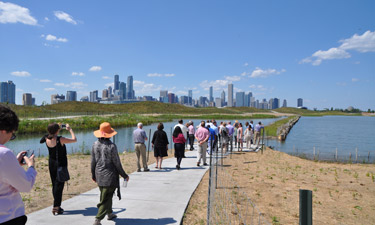 In today’s political and economic climate, creative tactics for retaining funding and growing revenue are essential items in the park and recreation professional’s toolbox. Comprehensively measuring and leveraging the economic impact of our facilities and programming goes beyond tallying the amount of taxes and fees collected in a given year — we must also consider how parks and recreation impacts the surrounding economy.
In today’s political and economic climate, creative tactics for retaining funding and growing revenue are essential items in the park and recreation professional’s toolbox. Comprehensively measuring and leveraging the economic impact of our facilities and programming goes beyond tallying the amount of taxes and fees collected in a given year — we must also consider how parks and recreation impacts the surrounding economy.
That question was the focus of NRPA’s most recent Innovation Lab, held July 30–31 in Chicago, Illinois, and hosted by the Chicago Park District (CPD). More than two dozen high-level park and recreation professionals, planners and consultants discussed what economic impact means, how it can be highlighted to its best effect and why this aspect of our profession is so critical to understand. Key to the discussion was CPD’s recently produced study, “The Power of Parks,” which sought to quantify the impact on the value of a given property based on its proximity to a park. This data would in turn help to demonstrate how much economic benefit CPD contributes to the city.
Chicago’s Economic Impact Study
The full results of CPD’s economic impact study are too dense to detail here, but Antonio Benecchi and Chad Coffman, of the Civic Consulting Alliance and Global Economics Group, respectively, who authored the report, offer some key takeaways:
- The impact of CPD assets adds at least $900 million — or 1.5 percent — to residential properties within .15 miles of parks.
- That impact is positive — although at different levels — across all park categories and city regions.
- Mini-parks, or small neighborhood parks sometimes referred to as pocket parks, contribute the largest relative impact (2.8 percent) and total dollar impact ($335 million).
- CPD’s diverse assets all contribute to economic activity from tourism, with its largest magnet properties (chiefly Soldier Field, Grant Park and museums) bringing in an estimated $1.2 to $1.4 billion in economic activity in 2013.
Recognizing Greatest Value
The takeaways above are merely a slice of the rich data available in CPD’s study, but they explain the agency’s two-pronged strategy when it comes to “getting more for our parks,” as CPD Superintendent and CEO Mike Kelly puts it. CPD hosts dozens of large-scale, profitable events each year at its magnet parks, harbors and museums, while simultaneously partnering with Choose Chicago, the city’s tourism agency, on a new neighborhood tourism push that seeks to establish yet more profit-value-increasing mini-parks.
Some of the country’s most popular attractions, including the NFL Draft, Lollapalooza music festival and the James Beard Awards, draw hundreds of thousands of tourists — and their wallets — to Chicago each year. That gets them into the city and CPD’s revenue stream. It’s hoped that cultural tourism initiatives, like Choose Chicago’s incredible effort to highlight the city’s diverse smaller neighborhoods and the rich activities they offer, will entice those same tourists to stay, and spend, an extra day or two.
Taking Risks, Making Gains
Kelly doesn’t mince words when discussing where his agency obtains the lion’s share of its revenue — “We don’t make our money from programming,” he says. “We make it from our special events.” CPD owns more than 600 assets, including 11 world-class museums and the largest municipally owned harbor system in the United States. Net revenue generated during special events at any of these amenities goes directly back to CPD, fueling maintenance, personnel, programming, community initiatives and related programs. These events take a great deal of time, energy and manpower to organize and execute, but, Kelly says, the payoff is more than worth any hassle. “I’ll take that $3.8 million [in revenue] from Lollapalooza and be able to send 3,000 kids to camp for free. I’ll use it for free swimming lessons. It’s that simple.
“You have to know your market,” Kelly continues. “If there is a market demand for a space, that space should be paid for.” Special events generate almost $5 million a year for CPD, and that massive number is made possible through a standard process that sees the agency act more like a landlord leasing an apartment, rather than a co-facilitator of an event. The permitting process is in writing and understood by all parties, reducing the potential for misunderstanding or friction once a given event is underway.
Aside from carefully curated commercial relationships, CPD also enjoys good working alliances with related city departments, including the police, Department of Natural Resources and various friends and environmental groups. All these strategies work in concert to facilitate a swift-moving, responsive and profitable agency. Kelly concedes CPD, with its remarkable holdings that draw such high-profile events, doesn’t operate like most agencies. “There is a lot of political risk in innovations like these, but you have to take risks to achieve this kind of economic success,” Kelly says.
Samantha Bartram is the Executive Editor of Parks & Recreation magazine.

